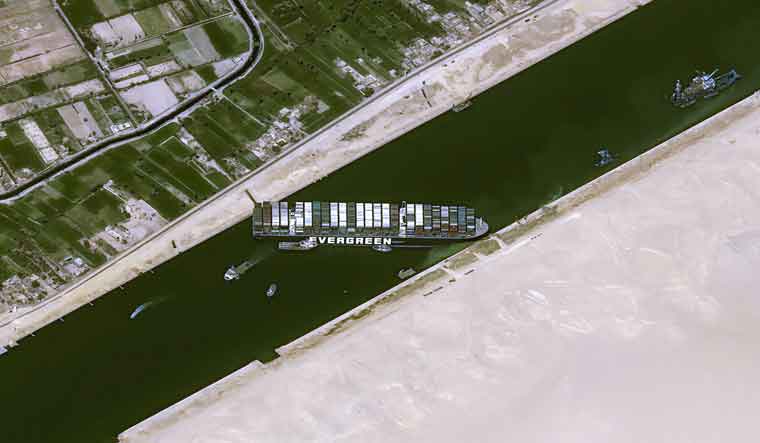MV Ever Given, the container ship that was stuck sideways in the Suez Canal, is floating again, a week after it ran aground in one of the world’s most important trade routes. After days of painstaking effort, the ship was wrested from the shore, but it is not completely free.
While engineers have partially re-floated the massive container ship, the canal is yet to be open to traffic and it is not clear how long it will take to clear the waterway.
The man-made channel enables around 12 per cent of the world trade by volume. The 224,000-tonne Ever Given’s predicament has forced over 250 ships, packed with a variety of cargo, to remain stuck on both sides of the waterway, putting pressure on global trade that was already strained by the coronavirus pandemic. Several ships even chose to take the longer (and more expensive) route around the Cape of Good Hope as a result of the blockage.
As news of the Ever Given being “re-floated” is met with cheers, we take a look at why the world was on its toes as the container ship got stuck in the crucial waterway.
Suez Canal’s history
One of the world’s busiest trade lanes, the 193 km-long Suez Canal is an artificial sea-level waterway in Egypt, built between 1859 and 1869, that connects the Mediterranean Sea to the Red Sea, providing an important, and also the shortest, sea link between Asia and Europe.
The construction of the canal, which was formally opened in November 1869, helped create a direct route between Asia and Europe, reducing the distance for ships navigating around the Cape of Good Hope in Africa’s southern tip by up to 7,000 km.
The French and British had stake in the company Universal Company of Maritime Canal of Suez which constructed the canal and operated it until the Suez crisis of 1956 when then Egyptian President Gamal Abdel Nasser nationalised the waterway, ticking off its European stakeholders.
The Suez crisis of 1956
In July 1956, when the United States and Britain withdrew their support in building the Aswan Dam, Nasser retaliated by nationalising the Suez Canal and using the revenue from the waterway to finance the project.
In an effort to “take back” the canal, Britain and France along with Israel invaded Egypt on October 29 until the US and the Soviet Union intervened.
Then US president Dwight Eisenhower put pressure on the Anthony Eden-led UK government, prompting the British and French to withdraw while the USSR’s Nikita Khrushchev threatened nuclear action on Western Europe.
The crisis ended, landing a humiliating blow to the colonial powers, with thousands of casualties on both sides. The canal was reopened for trade in March 1957.
The Six-Day War
Also known as the June War or the 1967 Arab–Israeli War, the Six-Day War was fought between June 5 and 10, 1967 between Israel and Jordan, Syria, and Egypt.
Prior to the Six-Day War, Nasser had announced that the Straits of Tiran would be closed to Israeli vessels, prompting the latter to reiterate that such an act would be a cause for war. After Nasser ordered the UN peacekeeping forces out of Sinai, Israel launched a series of airstrikes against Egyptian airfields.
Israeli forces occupied the Sinai peninsula, including the entire east bank of the Suez Canal. Egypt immediately imposed a blockade which closed the canal to all shipping.
The canal was badly damaged in the fighting and remained closed until after the 1973 Yom Kippur war.
 Israeli tanks at the bridgehead on the Suez Canal. Yom Kippur War, 1973 | IDF
Israeli tanks at the bridgehead on the Suez Canal. Yom Kippur War, 1973 | IDF
Yom Kippur War
The Yom Kippur War, also known as the 1973 Arab–Israeli War, was fought from October 6 to 25, 1973, by a coalition of Arab states led by Egypt and Syria against Israel. The objective of this conflict was for Egypt to regain control of the Sinai which was occupied by the Israeli forces after the Six-Day War. The war began on the Jewish holiday of Yom Kippur thus giving its name.
Both sides suffered heavy damage before the United Nations brokered ceasefire twice to end the war.
Egypt regained full control of the canal and it reopened in June 1975.
The canal is operated and maintained by the state-owned Suez Canal Authority (SCA) of Egypt.
Impact of Suez Canal on world trade
On an average, 50 ships pass through the canal daily, carrying around USD 9.5 billion worth of goods. Giant container ships, passing through the waterway, carry all kinds of cargo—from crude oil and automobiles to electronics and perishables.
Egypt raked in USD 5.61 billion in tolls in 2020 despite the coronavirus disruption. Over 18,500 ships passed through the canal last year.
Though the “re-floated” Ever Given is still blocking the canal, it will not have long-term implications on trade. However, it does put a dent on global and local trade.





